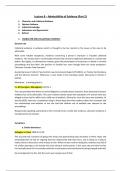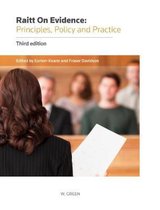Lecture 8 – Admissibility of Evidence (Part 2)
1. Character and Collateral Evidence
2. Opinion Evidence
3. Judicial Knowledge
4. Admissions and Agreements
5. Reform
1. CHARACTER AND COLLATERAL EVIDENCE:
General rule
Collateral evidence is evidence which is thought to be too remote to the issues in the case to be
admissible.
With some notable exceptions, evidence concerning a person’s character is included collateral
evidence. This means that it is technically relevant that someone might have behaved in a similar way
before. But legally, it's deemed too remote, given the presumption of innocence, to admit in criminal
proceedings and that that's the position in Scottish law, even though there are some exceptions.
Character includes ‘bad character’.
A potential area of reform? See Scottish Law Commission Report 229 (2012), on ’Similar Fact Evidence
and the Moorov doctrine’. Reference is also made to the Carolway report (discussed in Section 5
below).
Meantime… a starting place is:
C v M (Corrigan v Monaghan) 1923 SC 1
This case provides that where an action/litigation is actually about character, then obviously character
evidence has to be admissible. This case involved slander about the reputation of a woman who was
alleged to have had an affair and a child out of wedlock. Obviously, since the issue was character, (it
was the1920s, that was a scandalous thing in those days) then that evidence about her character and
her relationships and whether or not she had had children out of wedlock was relevant to the
proceedings.
But generally speaking, particularly in the criminal forum, similar fact evidence, character evidence is
not deemed to be relevant.
Exceptions-
a. Similar behaviour:
Gallagher v Paton 1909 SC (J) 50
The accused had a practice of going into shops and approaching shop assistants in these shops and
pretending that he had an ongoing business relationship with their boss, and in doing so, trying to
induce them to hand over some money to him. When he was tried for doing this, evidence was led of
his similar attempts to do exactly the same thing at earlier points in the same day and that he that
he'd actually done this in connetion with the circumstances that had led to his being charged and tried.
He took objection to this. But the court was having none of that.
, This is what the court said (per Lord M’Laren at 55):
‘I do not know of any better way of establishing criminal intention than by proof that he (the accused)
had made similar false statements on the same day to other people, and apparently with the same
object..’
If your behaviour, i.e. your pattern of behaviour, is such that it's leading up to the commission of the
alleged offence, then even though it is quite similar and it is technically character evidence, it's just
possible that it could be slipped into court on these grounds of Gallagher v Paton.
b. Other criminal Acts:
Dumoulin v HMA 1974 SLT (notes) 42
Mr. Dumoulin began his criminal trail in Germany, where through several fraudulent acts, he obtained
money from the bank. He set up everything in place to sign insurance documentation and then he
came to Scotland and he married a lady here. Then very shortly after the marriage took place, he took
her off for a walk up Arthur seat, he pushed her off the cliff and then tried to claim her life insurance
money. At his trial for murder, he objected to evidence that had been led about these other financial
crimes that were sort of connected to the ultimate aim, which was to marry someone and get a lot of
money for himself after he had brought about the untimely death.
The court said (per Lord Justice-General (Emslie) et al at 43):
‘In these circumstances, ex facie of the indictment, the transactions in Germany were an integral part
of the preparation for the commission of the crimes libelled in Scotland. It matters not where these
transactions took place, for the nexus libelled between these transactions and the charge of murder
in Scotland is clearly sufficiently close to make it impossible to sustain the objections to relevancy. It
follows that the evidence as to the transactions in Germany was competently admitted.’
Nelson v HMA, 1994 JC 94*
Mr Nelson was in the pub and he saw the police come in the door of the pub and he saw them making
their way towards him. He started to run away because he knew he had drugs on his person and he
ran down the pub hall to the men's loo being chased by a police officer. As the police officer opened
the door, he was just in time to see Mr Nelson quite literally, swallowing the evidence, taking some
illegal drugs. Mr Nelson was charged and in fact convicted of offences concerning the supply drugs. in
the course of his trial, there was evidence given about his behaviour swallowing the drugs, and he
wasn't actually being charged in connection with ingesting the drugs. He and his lawyers took issue to
that evidence being led.
On appeal, the conviction was upheld. It was help with that evidence was, in fact, closely connected
in time, place and character to the offence itself. It set the scene. So, again, slight shades of Moorov
there. And the way that the court described that. So that evidence of his character and his behaviour
connected to the crime, but not necessarily part of it was led legitimately and admitted in court.





